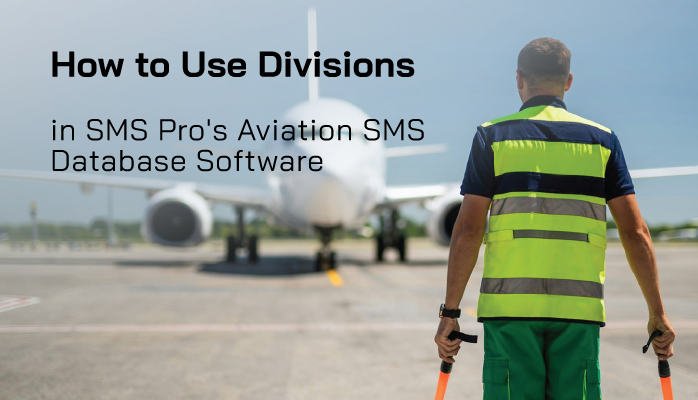What Are Divisions in SMS Pro

This is a question that comes up a lot.
Especially when we start throwing other words into the mix like:
- Departments;
- Portals; and
- Management Portals.
It can get confusing quickly. Many people ask – what’s the difference?
Aviation safety management systems (SMS) have considerable SMS documentation requirements that become more difficult to manage as years pass.
Related Aviation SMS Documentation Articles
- 5 Times Documentation Saves Safety Managers in Aviation SMS
- 4 Pillars | Why Documentation in Aviation SMS Is So Important
- Best Practices for Documenting Your Aviation SMS
Mature SMS implementations are expected to:
- demonstrate continuous improvement of the SMS;
- identify trends; and
- be regularly monitored.
The aviation industry has determined that operations are not as safe as can be expected and operators cannot be expected to "self-manage" safety. This is the core reason why we now have mandated aviation SMS. The objective of aviation SMS is to:
- proactively manage safety,
- identify potential hazards,
- determine operational risk; and
- implement control measures to mitigate identified risk.
Formally implemented SMS are designed to enhance operators' abilities to identify safety concerns and identify trends before they result in an undesirable event. Tracking all this information over one year time period is challenging for most aviation service providers. Now imagine tracking safety concerns and detecting trends in this collected data using five years' worth of data. In all but the very smallest of operators, an SMS database will be required to:
- collect data from multiple sources (reported safety issues, audits, vendors, etc.);
- store data;
- retrieve data to practice reactive risk management processes;
- generate reports for decision-making and informing regulatory agencies; and
- sorting, filtering, and grouping data to detect trends.
If your company has more than 40 employees, you should get an SMS database to manage SMS documentation requirements. If you have fewer than 40 employees but also have high employee turnover, I also recommend that you get an SMS database to assure accountable executives that the SMS can survive the departure of key safety personnel, such as the safety manager.
Smaller aviation service providers do not need complex data management processes; however, as the company grows these operators need SMS database programs that possess considerable flexibility and power. A best practice is to have all SMS data stored in one centralized data repository, which is the SMS database. This makes it easier to back up the data for disaster recovery. Another advantage of the centralized data management strategy is that SMS performance monitoring activities become much easier to manage. Otherwise, SMS performance monitoring will become unsustainable in the long run.
Related Aviation SMS Performance Monitoring Articles
- 4 Pillars | How to Conduct Safety Performance Monitoring and Measurement
- My Safety Score - What's Yours? Aviation SMS Performance Monitoring
- 5 Useful Safety Performance Monitoring Tools in Aviation SMS
Sloppy Data Management Shows Poor Planning to Everyone!
When operators use six different point solutions to manage SMS documentation requirements, the complexity of monitoring the SMS has just increased unnecessarily. A single solution that can address all SMS documentation requirements is a better data management strategy and SMS auditors appreciate this.
Whenever SMS data is found strung across the organization, it doesn't look professional to anyone, including SMS auditors. Sloppy data management shows everyone the poor or improper planning decisions made early in the SMS implementation. This is perfectly understandable that wrong data management decisions are made because the employees assigned to implement the SMS are either:
- safety managers;
- pilots or mechanics hired to be the part-time safety manager; or an
- operational department head from another department assigned to this special project.
SMS Database Design for Simple and Complex Operations

Assigned safety managers are not SMS database experts. Furthermore, these newly assigned safety managers may not understand SMS documentation requirements because in most cases, this will be their first SMS implementation.
Luckily, in the past dozen years, I've seen and worked with many SMS implementations. These operators have both simple and complex operations with between ten and 1,000 employees, in most cases. Larger operators usually have quality management systems that they have been re-purposing to manage SMS data. Consequently, I've only worked with a handful of SMS implementations with more than 1,000 employees.
Simple operators commonly have fewer than 80 to 100 employees and operate within a single industry segment.
Complex operators may have fewer than 100 employees but generally more than 100. Complex operators may also have different types of businesses, such as an aviation maintenance organization that also has a small airline in another country.
A complex operator may have considerably fewer than 100 employees. For example, consider a small, on-demand charter operator that also operates an FBO or a string of FBOs. This is fairly common.
Another example seen frequently is helicopter operators that may have one or two corporate jets that fly to countries requiring SMS. And when these helicopter operators are performing their own maintenance, operational complexity increases proportionately.
To take another example from airports, consider an airport authority that operates multiple airports. These airports may be small, but in many cases, I'll see one or two larger airports in the group along with a few smaller operations that may have between ten to thirty employees at each airport. While each airport is a simple operation, having a separate SMS database for each division will make SMS performance monitoring more difficult across the group of airports.
We also see airport operators that are part of a larger "port authority" that includes maritime operations, or a group consisting of an international airport, one or two regional airports, and the maritime operation. This becomes a complex operation with specialized SMS data management needs. How are these factors accounted for in the SMS database?
Related Aviation SMS Database Articles
- What Is an Aviation Safety Database for SMS Implementations?
- 5 Most Important Things to Know Before Buying Aviation SMS Database
- When You Need to Design an Aviation Safety Database for SMS
Complex Operations Require Complex SMS Databases
Simple operations don't have the data segregation requirements demanded by complex operations. It is easier to start with an example of a smaller complex operator to highlight this point. Let's take the aviation maintenance organization that also has a small airline in a different company. Let's call this operator AMO Airline Group (AAG).
The SMS of AAG is implemented. The SMS database is collecting safety assurance data from:
- reported safety issues; and
- audit findings.
During the risk management process of these collected data elements, actions will be performed to logically group reported issues and audit findings. Let's call these groupings "classifications." Classifications are simple associations to identified classification schemes, such as:
- Hazards from the hazard-risk register;
- Human factors;
- Root causes;
- Types of issues; or
- Locations where the event occurred.
Another universal risk management activity is the risk assessment process, where safety analysts determine operational risk by evaluating the likelihood and probability of damage to:
- personnel;
- equipment;
- environment; and
- reputation.
For each treated safety concern, there will be classifications and risk assessments. Simple enough.
Now, AAG's accountable executive wants a report of all the issues that deal with the Human Factors' classification "Fatigue" for:
- the entire company; and
- only the airline; and
- only the AMO.
As you can see, the SMS database needs a way to divide the SMS data in a way that allows management to focus on only one part of the operation.
Related Aviation SMS Database Articles
- How to Choose the Best Aviation Safety Database Software
- Pros and Cons of In-House SMS Database and Off-the-Shelf-Solutions (COTS)
- 7 Signs You Need an Aviation Safety Management (SMS) Database
So What Is a Division in an Aviation SMS Database Software

The quick answer is that a division is a way of breaking up a business into distinct units for:
- security (allow users to only see issues affecting their operations);
- report generation (allow management to focus on a particular part of the business); and
- reducing the complexity of the "system."
Depending on company size and operational complexity, this can be handled using different data management strategies.
But this answer hardly clarifies things.
I think the most effective way to approach this question is to first tell you what a division is not, then what it is. Then we can give an example of how Divisions are successfully used in an SMS database's organizational structure.
What a Division Is NOT
There are three primary functions that Divisions are not used for:
- Separate child companies under one parent company
This is the job of a portal. Each company with an operating certificate should have a single portal. Parent umbrella companies will have a Management Portal where safety teams can manage each child Portal. The best reason to give you for not putting companies with different certificates in the same portal is: What happens when management sells one of the companies?
This is a fairly common scenario in the aviation industry. Assets are acquired and sold off regularly. When your company sells one of the child companies, the SMS database must accompany the sale. Therefore, you will need a clean separation of data at the portal level.
- Organize User Roles
Within a division, any number of User Roles can be assigned to each employee. Those same User Roles will, for the most part, be universal across all divisions. That being said, there may be occasional User Roles that are specific to one Division, such as a Cabin Crew role as part of the Flight Ops Division.
- Divisions do not function the same as Departments
This is probably the source of the greatest confusion surrounding Divisions. At first glance they would seem to be very similar, however, as we shall see, Divisions and Departments in the SMS Pro database serve two distinct and different organizational functions.
Related Aviation SMS Database Articles
- How Long to Move into New Aviation SMS Database?
- Tips Writing SMS Manuals With Aviation Safety Database Solutions
- See How Spreadsheet Not EASA Compliant Aviation Hazard Reporting Database
What a Division IS
When we are talking about how to use Divisions in SMS Pro, we are usually talking about using them to:
- Separates a company into its various functional units
For example, an aviation company would probably create different divisions for Flight Ops, Maintenance, Ground Handling, etc., because each of those units serves an entirely different purpose – i.e., function – for the company.
As another example, let's consider a corporate charter operator that also operates an FBO and/or an AMO. Divisions allow the company to keep the users and data separate while allowing upper management to easily monitor SMS performance.
This practice is much less common than using Divisions to separate functional units, though in certain cases it makes sense to use this route. An airline company that has bases in various continents may choose to use Divisions for its geographical units. A Division should be used in whatever ways a company feels is best to analyze its hazard risk data.
- Allows Users/Department of a Division to have access to report issues that are only relevant to them
For example, the Safety Officer in the Flight Ops division will be most concerned with issues in – you guessed it – Flight Ops and need not be distracted by all issues in other Divisions. This is an important point because it implies that: One of the primary functions of Divisions is to maintain simplicity in aviation hazard risk management
For large, more complex systems, a company will need more Divisions to keep SMS data organized. Divisions reduce data complexity.
Without divisions in a larger company, the top-level management could easily be overwhelmed by so many issues filtering to the top. This logically occurs because there are many more reported safety issues to address in larger companies, especially those with healthy reporting cultures.
For smaller, more straightforward operations, it’s probably in the best interest financially and of their time to have fewer divisions so that things can filter to the top more quickly.
- Allows HR, IT, Security, or Quality departments to have their own workspace
There are times when the company wants to use the same SMS processes with other organizational units. For example, an airport will have a "Security" department. The Security department doesn't want managers or auditors snooping into the Security data, or vice-versa. Divisions allow a clean separation of data. It is like having two databases, but only certain managers can see data across all divisions.
Another common scenario is having HR or HSE, OSHA, or OHSA departments use the SMS database to track their own types of issues. Divisions have risk matrices and classification schemes, so they can modify their division to suit their operational requirements.
Related Aviation SMS Database Articles
- How European Operators Know They Need Aviation Safety Management Systems (SMS) Database
- 3 Benefits of Aviation Safety Management System (SMS) Databases
- How to Manage Aviation SMS Without Complex Databases
How Are Departments and Divisions Different?

Here’s the rub. Fortunately, there is enough difference between the two that clarifying their use is fairly straightforward.
It works like this:
- Divisions separate the functional/geographical units of a company – the point being that the different units’ purposes do not overlap with one another
- Departments separate the various, overlapping and coinciding duties within a division
A good example would be inside a Ground Handling division.
A company may choose to have Departments for Baggage Handling and Baggage Cart Drivers.
Both Departments in this case work towards the same common goal of handling ground operations, but the operational goals of Ground Handling and Flight Ops are different.
So, a catchier way of answering the question is:
- Different Divisions, Different Goals
- Different Department, Common Goal
Example Uses of Divisions
Let’s take three fictional companies and see how they might use divisions differently.
#1 Aviation A is a small airline with 100 employees that flies in a limited geographical area, say among the Hawaiian Islands. Because they are small, it does not make sense financially or organizationally to take the time/money to:
- Purchase additional Divisions
- Configure the setup of those Divisions
- Try and assign/manage users for each Division
because their safety reporting volume would be fairly small.
#2 Aviation B is a medium-sized airline that operates along the West Coast of the United States. They have around 150 employees, so it would probably make sense to have probably two or three divisions based on:
- Function, such as Flight Ops, Ground Handling, and Maintenance
because it would be in their best interest both in terms of time and money to maintain the organization by segmenting these groups.
#3 Complex operator A has
- three aircraft devoted to charter operations;
- six FBOs;
- one aviation maintenance organization; and
- a small flight school.
In this case, I would have one division for the FBOs, one for the AMO, and a shared division for charter and flight schools.
Summary of What Divisions Are and How to Use Them
To make a long story short, a Division:
- Segments and filters safety data into functional/geographical units to be dealt with separately
- Keep reported safety issues and audit findings organized and maintain simplicity
- Allows management to focus on business units to apply risk management strategies
- Secures data according to business needs (need to know).
As far as best practices, a company should use Division(s) in whatever way keeps the organization structure the simplest and most efficient.
Should you still have questions or concerns about how to use Divisions most appropriately in your setup, please contact us – we are happy to help.
Did this provide some insight into what Divisions are and how they are used in SMS Pro? Let us know in the comments below.
Divisions play an important role in the risk management workflow. Users belong to only one division. To see how SMS Pro works, please watch these short demo videos:
Last updated February 2025.








